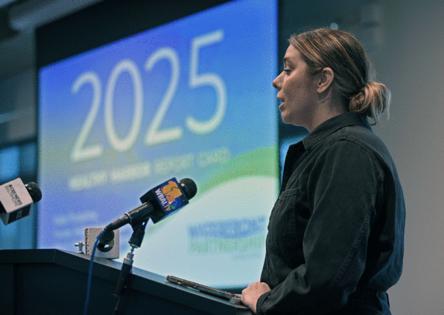Smell that? Baltimore harbor health improves despite pistachio tide
Published in Science & Technology News
BALTIMORE — Despite the pistachio-colored glow and sulfurous odor, the Baltimore harbor continues to improve in water quality year after year — even if swimming right now isn’t advisable.
Officials from the Waterfront Partnership and City of Baltimore said Friday the annual Healthy Harbor Report Card shows significant improvement in water quality, including swimming safety and harbor ecology.
“You only had to walk outside in the last couple of weeks to understand how important the harbor is to all of us,” said Dan Taylor, president of the Waterfront Partnership. “The harbor matters, but it seems like a relatively recent phenomenon that we care about it.”
Report highlights:
—Most improved sample site: 84% of Fells Point bacteria samples passed the mark for human safety.
—Jones Falls outlet bacteria scores improved by 60% since the beginning of sampling in 2010
—Overall Ecosystem grade: C
—Dissolved oxygen: A
—Chlorophyll a: D
—Water clarity: C-
—Nitrogen: C-
—Phosphorus: C
According to the report, started in 2010, the harbor has seen steady improvement in safety for humans since the Waterfront Partnership formed and began taking measurements. In 2023 and 2024, more than 80% of the water quality tests returned acceptable scores for bacteria and trash, compared to 50% in the early years.
“I had no concern at all that the harbor was safe to swim in when we went out in early June, ” for an organized swim,” Taylor said. “Even today, we’re at a place where the baseline condition of the harbor is pretty healthy and clean. That means when something bad happens, it’s news.”
While the harbor is usually safe for swimmers, the report graded the overall ecosystem at a C for the health and safety of animal life, showing a lack of resilience. That means the harbor is vulnerable to intermittent changes in water quality caused by algae blooms, pollution, and so-called turnover events, including the one that killed thousands of fish on Sept. 23, heralding a weekslong pistachio tide with its signature sulfur smell.
A turnover happens when cooler nights cause surface water to grow more dense and drop, flushing out a large, persistent oxygen-depleted dead zone in the deeper parts of the harbor. This drops the oxygen content of the whole harbor, killing fish, crabs, and other wildlife.
Unfortunately, the pistachio tide is showing no signs of improvement, said Adam Lindquist, vice president of the Waterfront Partnership.
“The geographic scope and severity of the pistachio tide we’re experiencing now is unprecedented,” Lindquist said. “Dissolved oxygen in the water has stayed at zero since Sept. 28. … Right now the harbor needs a major pulse of oxygen to bring it back to life.”
Hopefully, rain from a nor’easter forecast to hit Maryland this weekend will flush out nitrogen pollution and increase oxygen content and circulation, he said.
Professor Eric Schott, of the University of Maryland Center for Environmental Science, announced the formation of a working group with partnership members and colleagues including Sarah Preheim, an environmental health and engineering professor from Johns Hopkins University. They will start looking for solutions to the annual turnover event and dead zones, though he cautioned it will take time, investment, and consensus on solutions to see a difference.
“We have a pretty good idea of what causes these turnovers,” Schott said. “It’s become normal-ish.”
Because the harbor is a deep box with no shoreline, natural processes will not be enough to help it recover, he said.
Matthew Garbark, director of the Baltimore City Department of Public Works, said the city is working to reduce nutrients like nitrogen and phosphorus flowing into the harbor. The department’s main initiative to accomplish this is to eliminate overflow events from the city’s two sewage facilities, such as the Patapsco Wastewater Treatment Plant failures in 2021 that caused one of the worst report card results in the last five years.
Residents can help as well, he said, by not littering or flushing oils, fats, or trash into the sewers and by picking up pet waste. The mayor’s fall cleanup event will also be held on Oct. 25, and communities can register their cleanup activities for the day by calling 311.
Katie Pumphrey, an artist and ultramarathon swimmer, also announced the formation of Baltimore Open Water Swimming, a nonprofit group that will promote group swim events on a pop-up basis throughout the year to increase opportunities to appreciate the harbor from within.
“As an open water swimmer, I think all the time about water quality and weather and how it will affect my swimming,” she said.
©2025 Baltimore Sun. Visit baltimoresun.com. Distributed by Tribune Content Agency, LLC.







Comments